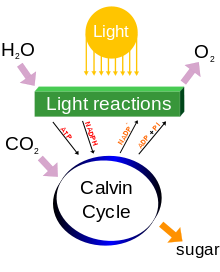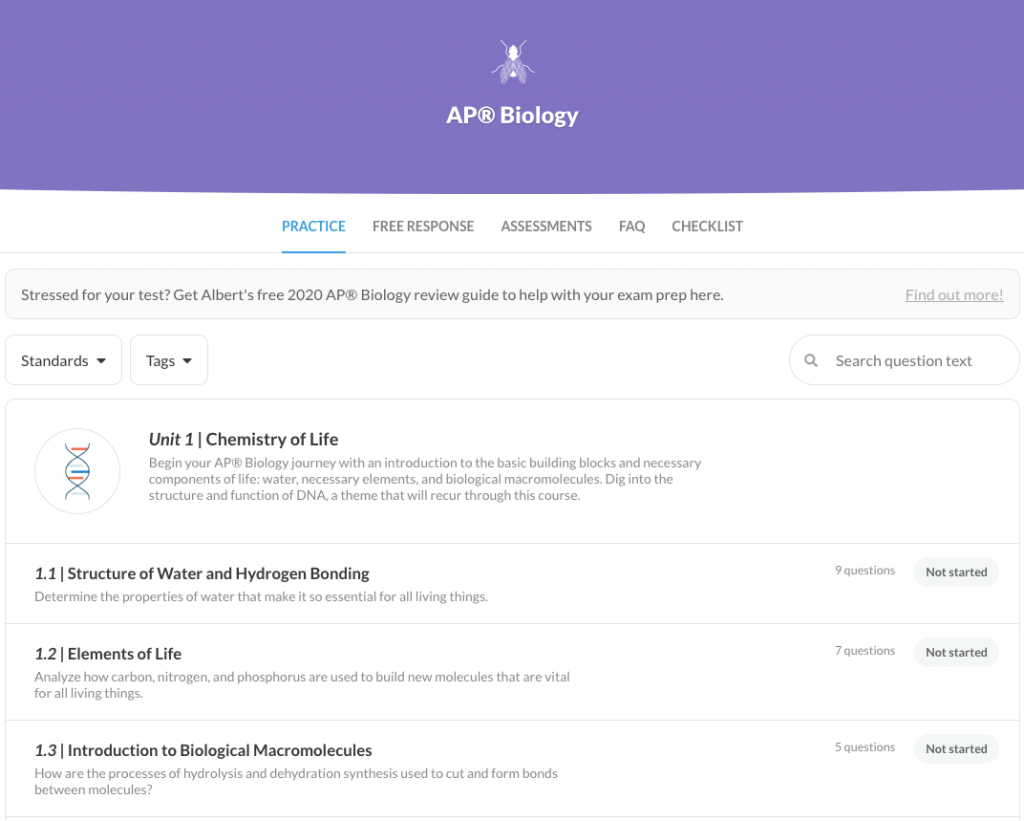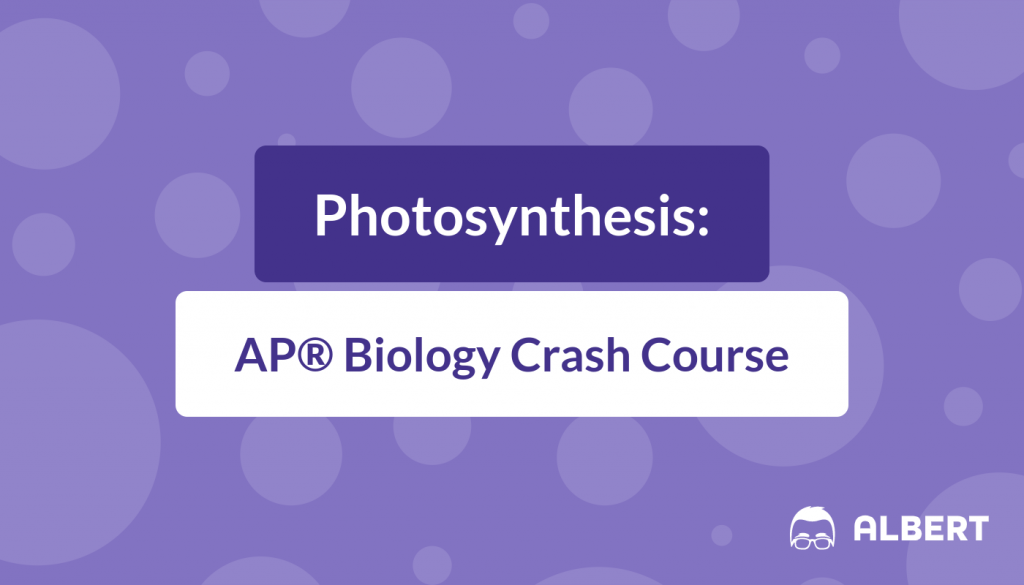There’s a lot of information in the Advanced Placement (AP) Biology photosynthesis unit that can distract you from remembering its most important concept: the transformation of light energy into chemical energy, and then its storage in the bonds of carbohydrates.
Instead of giving you a laundry list of processes and reactions, we are going to discuss the pathway of light energy in plants. We think a pathway is easier to remember and maintains the focus on energy transduction.
LIGHT: THE DRIVING FORCE OF PHOTOSYNTHESIS
When light hits an object, photons are reflected, transmitted, or absorbed. The term photon here emphasizes the particle-like behavior of light, as opposed to the wave-like behavior of light. Reflection and transmission constitute what we perceive as color. Absorption is what allows photosynthesis.
Plants take advantage of the fact that some photons can be absorbed and use the energy of these photons for photosynthesis. This energy conversion takes place in the chloroplasts of the plant cell, where light energy is converted to chemical energy. Photons with more energy than a given electron in the chloroplast will transfer energy to the electron by the mechanism of diffusion. The electron then acts as an energy carrier, transferring its energy to be used for many reactions in photosynthesis.
We say that light is the driving force behind photosynthesis because light is the original provider of the energy used in the photosynthetic process. The first set of reactions in photosynthesis are called “light-dependent” reactions because they need light energy to start and continue. The second set of reactions are known as “light-independent” reactions as they function using the energy produced by the first set of reactions, but not the photons themselves.
We will highlight the key points you need to understand to fully take advantage of this surprisingly simple AP® Biology photosynthesis exploration. The first time, read through as if you are reading a story; this will give you the bigger picture, and it will help you avoid getting lost in the jargon. Next, read again focusing on the details; always keep in mind what the purpose of each system, enzyme and molecule is. This will help you understand the concepts instead of cramming for your AP® Biology exam.
THE LIGHT-DEPENDENT PHASE
LIGHT ABSORPTION
Once light energy (in the form of photons) has been absorbed by the chlorophyll and other pigments of the chloroplast, this energy needs to go somewhere. The energy is transferred to the photo systems of the chloroplast – bundles of chlorophyll pigments packed into thylakoids. Thylakoids are membrane-bound sacs inside chloroplasts where the light-dependent reactions of photosynthesis occur. The energy is carried by electrons; these electrons are known in this state as “excited” electrons. The excited electrons concentrate in the thylakoid membrane proteins, which power photosynthesis. The photosynthetic process begins in Photo system II – so called because this photo system was the second photo system discovered (don’t get confused – Photo system I is used later in photosynthesis!).
In Photo system II, light energy from photons splits water into its constituents:two H+ ions,two electrons, and a single oxygen atom in a process known as photolysis. The electrons released are transferred to P680 molecules while the oxygen atoms combine to form O2, which is released into the atmosphere, and the H+ molecules remain in the thylakoid membrane for later use in the conversion of NADP+ to NADPH (remember this – we will come back to it later). P680 is a bundle of chlorophyll pigments located within Photo system II that acts as an oxidizing agent (currently no stronger oxidizing agent is known to exist!). The first stage of this reaction, the photolysis of water, occurs as follows:
2H2O ®4H++ O2 + 4e–
THE ELECTRON TRANSPORT CHAIN
At this stage, we introduce the electron transport chain, which is the mechanism by which electrons are transferred from the thylakoid membrane proteins to the NADP+ molecule – all of this occurs to produce ATP and water necessary for the plant’s growth. The beginning of transport chain is Photo system II, where electrons are first excited by light. Electrons released by the reduction of NADH2 then progress along the chain, where their energy is dissipated as heat or converted to ATP energy – the power of the cell. The reduction of NADP+ occurs as follows:
NADP++ 2e–+ 2H+®NADPH + H+
ATP PRODUCTION
It is at this stage that photosynthesis can be broken into cyclical and non-cyclical processes. We will focus on non-cyclical photosynthesis.
Non-cyclical photosynthesis is described by the following equation:
2 H2O + 2 NADP++ 3 ADP + 3 Pi+ light → 2 NADPH + 2 H++ 3 ATP + O2
Each molecule of chlorophyll absorbs one photon of light. This excess of energy causes the photon to release an electron into Photosystem II, where it changes the P680 molecule to a P680*. This releases the electron, which is passed through various molecules in the electron transport chain. The electron transport chain causes a proton gradient across the chloroplast membrane. This gradient is used to produce ATP from ADP during photo phosphorylation.
After the reaching the plastocyanin, the electrons move into the P700 of the Photo system I, converting it to P700*. At this stage, the electrons are further excited by light energy absorbed by the Photo system I. The electrons travel further along the electron transfer chain, from the Photo system I to membrane-bound iron sulfur proteins to ferredoxin molecules, losing part of their energy to molecules of the ETC at each stage. This energy is used to further the proton gradient across the chloroplast membrane, and the electron reduces the NADP+ molecule to NADPH.
Systems seek to restore the equilibrium of concentrations, so by chemiosmosis, extraneous protons are forced back to the outer membrane of the thylakoid. The channel that the extraneous protons exit the membrane through is known as ATP synthase. This motion of protons rotates the ATP synthase protein and phosphorylates ADP to ATP.
In the diagram below, the transfer of an electron from excitation by a photon of light energy (far left) through Photo systems II and I, to the formation of ATP and NADPH is depicted. It should be noted that the electrons travel in one direction, while the NADPH and ATP produced are used in the furthering of the photosynthetic cycle.

Image Source: Wikimedia Commons
Figure 1: The movement of electrons along the electron transfer chain.
Losing electrons causes both photo systems to have a positive charge and become strong oxidizing agents, so they oxidize surrounding water molecules to obtain their electrons. This breaks the molecular bonds of water and dissociates it into its components, oxygen and hydrogen, which are released and used to form NADPH. This all occurs in the thylakoid membrane of the cell.
If you’re familiar with cellular respiration, you may be experiencing déjà-vu! Indeed, the process of ATP production is similar for both cellular respiration and photosynthesis. This AP® Biology photosynthesis review can also help bolster your understanding of cellular respiration.
KINETIC, POTENTIAL, AND THEN CHEMICAL ENERGY
We’ve discussed how water molecules are used to create the proton gradient, but this gradient is also created by regular diffusion. Some of the energy from electrons moving down the electron transport chain is converted to kinetic energy in order to bring in hydrogen ions released into the thylakoid membrane during the photolysis of water (remember, we discussed this at the start of the article).
Once in the inner space of the chloroplast, the kinetic energy of hydrogen is considered potential energy because of its position in the proton gradient. Potential energy can be considered as energy that is available to use for work.
We consider potential energy to be converted to the chemical energy in ATP bonds because it was usedto turn ADP into ATP by rotating ATP synthase.
LIGHT INDEPENDENT REACT®IONS
The released hydrogen protons are also used to reduce carbon dioxide into glucose in the second set of reactions in photosynthesis, called the Calvin cycle. This process also uses the ATP and NADPH’s stored energy to perform this reduction. The reaction is as follows:
3 CO2 + 9 ATP + 6 NADPH + 6 H+ → C3H6O3-phosphate + 9 ADP + 8 Pi + 6 NADP+ + 3 H2O
Most plants can put three carbon dioxide molecules into an enzyme called ribulose bis-phosphate carboxylase (RuBisCo) to produce PGAL. ATP and NADPH are used to convert sugar back and forth from RuBisCo, but the final output is one PGAL. PGAL stores the energy for later conversion to sugars.
Therefore, the chemical energy that was carried by ATP and NADPH become stored in PGAL.
THE CALVIN CYCLE
The Calvin Cycle occurs in three main parts: fixation, reduction, and regeneration. During fixation, a RuBisCoenzyme catalyzes a reaction between 3 CO2 molecules and three ribulose biphosphate (RuBP) molecules. This forms six molecules of 3-phosphoglyceric acid (3-PGA). The cycle completes three times, during each of which one RuBP and one CO2 molecule interact. This is known as carbon fixation. During reduction, the ATP and NADPH created in the first stage of photosynthesis are used to convert the 3-PGA to glyceraldehyde 3-phosphate (PGAL). ATP is converted back to ADP in this reaction, and NADPH is converted back to NADP+. These products are recycled in the first phase of photosynthesis – the light-dependent phase. During regeneration, PGAL is exported to produce food products such as carbohydrates. This occurs in a 1:5 ratio: for every turn of the Calvin Cycle, two PGAL molecules are created. As it takes three turns of the cycles to use all RuBP molecules, six molecules of PGAL are created. One is exported, while five are used to regenerate RuBP. The one PGAL expelled collects in the cytosol. Once several have collected, PGAL molecules react to form sugar, in the form of six-carbon phosphates, which in turn react to form sucrose.
In the image below, the interaction between the light-dependent and light-independent reactions is shown. The products of the light reactions used in the Calvin Cycle can be seen, as are the products of the Calvin Cycle which are then reused in the light reactions.

Image Source: Wikimedia Commons
Figure 2: The interaction between the light-dependent and -independent parts of photosynthesis.
CONCLUSION
After a long trip, the spare light energy settles down and is stored in PGAL!
When the plant needs energy to perform metabolic processes, sugars created by photosynthesis are broken down and the chemical energy is released, much in the same way as food is broken down for energy in animal cells. In this way, light energy (as well as a few other products – can you name them?) is used to create carbohydrates that can be stored and used as “food” energy.
We mentioned that there are similarities explored in photosynthesis and respiration. Can you name other aspects of cellular processes that are similar to those mentioned in this crash course of AP® Biology photosynthesis?
Need help preparing for your AP® Biology exam?

Albert has hundreds of AP® Biology practice questions, free response, and full-length practice tests to try out.








